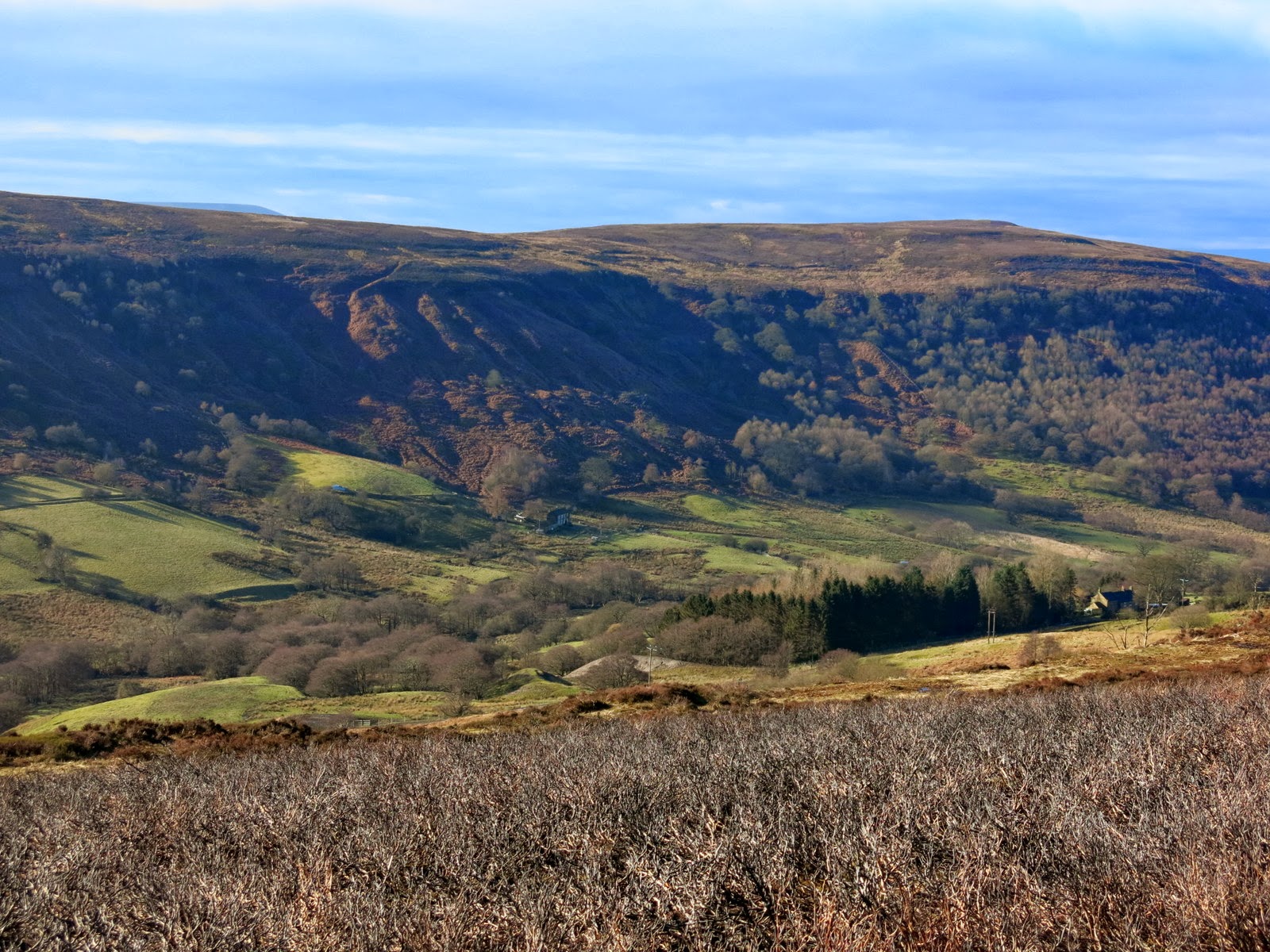Exploring Scugdale from Carlton Bank
7 miles Fair, little wind
We parked in the Lords Stones Cafe car park and crossed back over the road to walk uphill on the old gliding club roadway.
 |
| Map of today's route from The Walker's Guide to the Cleveland Hills |
 |
| Looking back towards the Lords Stones and Roseberry Topping from Gliding Club roadway |
On reaching the top of the moor we turned left onto a footpath which leaves the roadway. Until last year the view to the right was spoilt by the old Gliding Club but now no trace remains of the buildings and the moor stretches out on all sides. The first feature of note is Stone Ruck to the left of our track, a pile of large rocks which looked very spooky in the mist the last time we walked here. Shortly afterwards we arrived at Brian's Pond to the right of the track. In summer Clive and I have seen large numbers of dragonflies hovering here.
 |
| Carlton Moor |
 |
| Stone Ruck |
 |
| Brians Pond |
From Brians Pond our route climbed steadily over Clough Gill Top to the moor rim where we suddenly had a fine view of Scugdale below us. Tom Scott Burns tells us that Scugdale comes from the Danish 'skygger' meaning 'to overshadow'; so Scugdale would have meant 'the sheltered dale'. We have walked this route several times but today's fine weather gave us our best views of the dale. Our trail eventually led us to the rugged cliffs of Barker's Crags from where we looked down into Scugdale.
 |
| Clough Gill Top |
 |
| Surprise view into Scugdale |
 |
| The edge of Barker's Crags |
|
|
We descended from Barker's Crags to the dale road and turned left to walk up to the head of the valley and High House. This is an old farmhouse where TSB tells us lived a certain Harry Cooper who was reputed to be the tallest man in the world, standing at 8'6". He joined Barnum's Circus in America and died in 1898 at the age of 41. The farm was very quiet today with no sign of life as we walked past and turned right over a field stile and down the hillside to cross Scugdale Beck. The slopes on the opposite side of the dale showed their mine workings in relief as the sun shone on them. Alum and jet were mined here as well as iron ore.
 |
| Dale road through Scugdale |
 |
| Jet mine workings show clearly on the hillside |
 |
| High House |
 |
| Outbuildings at High House |
 |
| Looking down Scugdale from High House |
When we arrived at the beck we found that storms had washed debris down the beck completely marooning the bridge which sat uselessly amongst a pile of silt and stones which had diverted the beck. Fortunately it was passable without the bridge.
 |
| Walking downhill to Scugdale Beck |
 |
| The bridge is no longer over water! |
 |
| In need of a clean-out |
Our route now followed the other side of the valley, crossing fields below the old alum workings. There was no path and we picked our way through the boggy grass, occasionally seeing a yellow waymark. This route is obviously little walked. Just before we arrived at Holiday House, another old farm building, we stopped in a sheltered spot and enjoyed our coffee and scones in the sun while looking across at Scugdale Hall and Barker's Crags above it.
 |
| Scugdale Hall from our coffee stop |
 |
| Barker's Crags |
Setting off again we were sorry to see that Holiday House appeared deserted and in poor repair. The last time we walked here there were pet goats, sheep and fancy hens and a flag flew cheerfully above it. Today there were no animals to be seen and disrepair everywhere we turned. We wondered what could have happened. Leaving the farm we walked along the path to rejoin the dale road before turning right at a green metal footpath sign at Fog Close Farm.
 |
| Holiday House Farm |
 |
| Fog Close Farm |
After passing the farm buildings we made our way left, following yellow way-marks, steeply uphill onto Live Moor. As we walked along the ridge we looked down into the little known valley of Snotterdale, where there is no road or path access.
 |
| Looking down into Snotterdale, Scugdale in the distance |
 |
| Climbing to Live Moor |
 |
| Walking along Live Moor |
Opposite a conifer plantation our path turned left across Carlton Moor where we eventually joined the Coast to Coast walk for the last few hundred yards to the trig point at 1338 feet. From here we looked down on the steep stone path to Lords Stones and our car.
 |
| The old Gliding Club runway |
 |
| Whorlton Hill from Carlton Moor |
 |
| Trig Point above Carlton Bank |

